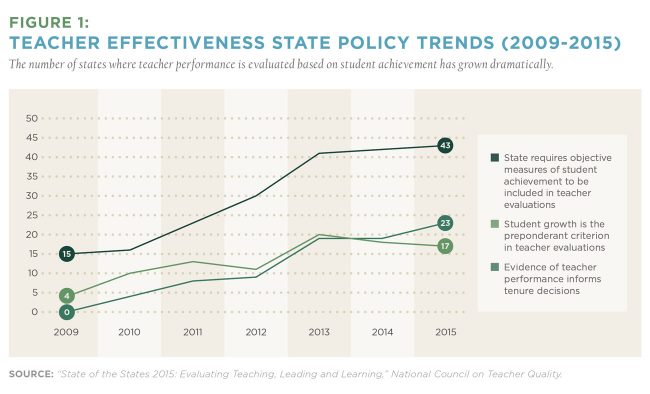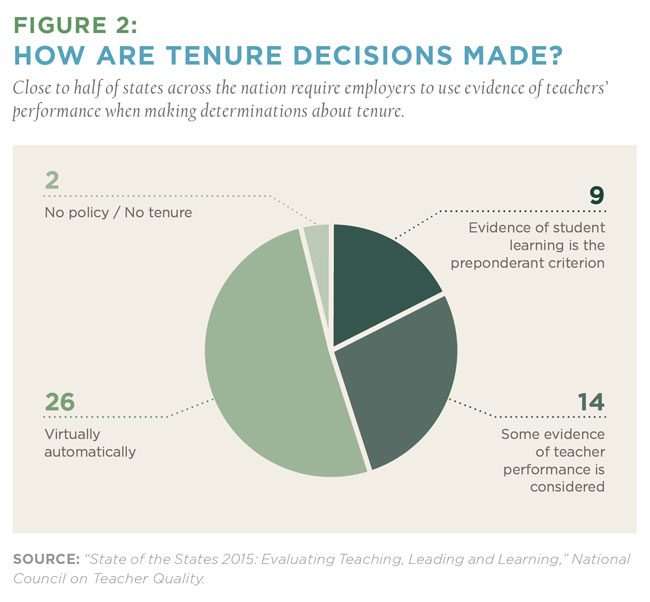 By Joshua Cowen
By Joshua Cowen
Associate Professor of Education Policy
Department of Educational Administration
jcowen@msu.edu
@joshcowenMSU
Is there a war on teachers? It can feel that way. Over the last half-decade, policymakers across the country have attempted fundamental changes to many aspects of the teaching profession. Teacher-related policy reforms have included new efforts to monitor and improve teacher preparation, overhaul teacher evaluation in most states and limit collective bargaining by teachers’ unions and membership in unions themselves. Teacher advocates have pointed directly to these reforms to explain new exits from the profession, as well as shortages resulting not only from those exits but from steep declines in the number of would-be teachers choosing careers in the field. Such a story, if true, would represent perhaps the most important problem facing public schools today. If researchers studying teacher-related policies can agree on one thing, it’s that teachers are the single most important school-based influence on student outcomes. What we don’t know yet, however, is enough to say for certain what impact these policy reforms have had on the teaching profession, much less student achievement overall.
As I’m going to argue here, much of what we don’t know is empirical. Because most of the reforms implemented have been phased in over the last five years, there has been simply too little time to draw meaningful conclusions about their effects—especially over anything approaching the long run. But part of the problem can also be thought of as a conflict of theory. Supporters of many of the most hotly debated policies—the use of student test scores to evaluate teacher performance, the potential for job dismissal as a result of that performance and weakening teacher tenure and seniority protections chief among them—have argued that school leaders need the flexibility to hire, assign, transfer and, if need be, dismiss teachers according to the needs of the school and the children they serve. Opponents have argued that student test scores are a poor measure of teachers’ overall contribution to child success. They say teachers feel threatened and demoralized by new employment insecurities and that seniority-based staffing rules provide a means for the most experienced and committed teachers to rely on a stable, well-defined set of workplace conditions not subject to ad hoc or at-will administrative decisions.
Will evaluating teachers improve education?
These competing views of recent reforms—and the current scarcity of evidence to resolve the disconnect—are most apparent in two specific areas of policy change. The first is teacher evaluation. In 43 states, student achievement is included in teacher performance measures, with achievement growth the dominant criterion in 17 states and the results of these ratings used to inform teacher tenure decisions in 23 overall (National Council on Teacher Quality 2015). Tying teacher jobs to test scores certainly has received the most attention. This is partly because of skepticism in the way districts use those scores. I would characterize the research-based consensus (though by no means unanimous) in the following way: statistical techniques for attributing test score growth to individual teacher contributions—a class of strategies known as value-added modeling—appear valid in many, carefully controlled settings of practice. We know, in other words, where the major strengths and limitations of these measures lie, and this is an important and under-valued feature of their construction (Goldhaber 2015). Their use in high-stakes teacher evaluation are, however, problematic, because even relatively accurate performance measures are imprecise and can vary from year to year for individual teachers. That poses difficult problems of implementation, and we simply don’t know how many teachers may be affected by fluctuating measures of effectiveness.
But the other, more fundamental uncertainty exists well beyond test scores. All states using test scores also continue to evaluate teachers based on principal or other supervisor classroom observations. These observations, based on well-known tools like the Danielson Framework or the Marzano Teacher Evaluation Model, have been around for years. They are vulnerable to all of the same major critiques—especially those rooted in reliability, validity and concerns about objectivity—as test-based evaluations. What’s new, and even more significant a break from the past than the use of test scores alongside these measures, are in fact the high stakes themselves. A decade ago, most teachers faced little or no threat to their employment as a result of classroom performance. Now many do, whether that performance is measured primarily by test scores, observation or some combination thereof.
The big question is: what has—and, really, what will—all of this do to the distribution of teachers between and within schools. We are beginning to see evidence in certain locales—Washington, D.C., for example—of positive teacher response to a combined package of high-stakes evaluation and new financial incentives for effective teachers, including self-selection out of the profession by less effective teachers (Dee and Wyckoff 2015). Since researchers have long known that historically disadvantaged children are especially likely to be served by ineffective or inexperienced teachers, new evaluation programs coupled with greater efforts to recruit and retain high-quality teachers may be one way to improve education in hard-to-staff areas. On the other hand, teacher turnover is already high in those areas, especially in urban environments, and as I and other researchers have shown, many of the least effective teachers tend to exit public schools on their own (Cowen and Winters 2013, Goldhaber, et al. 2011). This means that while overall teacher quality may improve as a result of new evaluation policies, that improvement may be overstated (Winters and Cowen 2013a). This may be especially true in the very schools that policymakers are trying to improve: Although teacher shortages do not exist everywhere, staffing needs remain greatest in schools whose kids tend to need high-quality teachers the most.
Are teacher unions good for students?
This brings me to the second major area of policy change, and probably the one where most of the ground has been staked in the narrative “war on teachers.” Forty-four states have passed major legislation aimed either explicitly at teacher unions, union priorities or at teacher rights as historically dictated by their collective bargaining agreements, including not only teacher evaluation and dismissal but compensation, seniority-based staffing decisions and union membership itself (Marianno, forthcoming). Teacher tenure is guided by state law and not, typically (as is often assumed), by individual district contract negotiations. Tenure remains a key union priority however, and in addition to the 23 states that require evidence of effectiveness to guide tenure decisions, seven states have enacted laws that allow districts to remove tenure protections from teachers if they don’t meet performance standards (Thomsen 2014). Three states have passed laws that effectively eliminate tenure and/or due process rights for permanent teachers.
We simply have no evidence for whether these changes will ultimately either promote or hinder the education of children. Union opponents have argued that tenure and reverse-seniority layoffs (policies known as “last in, first out”) force administrators to keep ineffective teachers in classrooms. They also argue that such policies can exacerbate teacher shortages in hard-to-staff areas which, as I have noted, tend to be staffed by inexperienced teachers who are most vulnerable to district-wide layoffs or reductions in force (these are essentially the arguments underlying the plaintiff’s case in Vergara v. California, which was recently overturned by a panel of three appellate judges and is awaiting appeal to the California Supreme Court). We do know that removing tenure protections could result in removing ineffective teachers from the classroom (Winters and Cowen 2013b), and we do have some evidence that layoff policies based on effectiveness instead of seniority would improve access to high-quality teachers overall (Boyd, et al. 2011) and possibly improve student achievement (Kraft 2015). But we also know that teacher tenure is an important feature of employment, not simply as a means of ensuring due process in cases of dismissal, but far more commonly as a non-monetary incentive to enter and to stay in teaching. Removing tenure without adding substantial new incentives (such as the financial incentives in Washington, D.C.) removes a major way to attract new teachers into the profession (Rothstein 2012, 2014).
There is also, more generally, the question of whether teacher unions (and/or these and other policies they espouse) are good for school children. As with any of the specific reforms, it depends on whom we ask. Union advocates argue that their organizations promote higher pay, better working conditions and the very job security targeted by recent reforms, that these outcomes are good for teachers and that what’s good for teachers is good for kids. The same arguments against tenure, seniority-based staffing and compensation decisions apply broadly to arguments opposing teacher unions: that collective bargaining restrains administrators from making decisions based on what’s best for schools and the children within them. And as in these more limited debates, we simply don’t have enough evidence yet. We do know that unions tend to drive up teacher salaries and lower class sizes, but because the verdict is very much out on whether higher pay and lower class size actually results in gains to student outcomes overall, we don’t know whether these higher costs are actually associated with greater benefits to kids (Cowen and Strunk 2015). Complicating our ability to study that question is that unions differ between and even within states in the extent to which they negotiate restrictive or flexible bargaining agreements, and whatever factors explain these differences may themselves influence student outcomes, too (Cowen and Strunk 2015). Simply put, what it means to work in a unionized district, and how that matters for student outcomes, varies across the country.
Looking for new evidence
So much uncertainty. This is the nature of policy analysis, and social science more generally. Rarely are the impacts of public policymaking or public program implementation as clear cut as either advocates or proponents of these changes suggest. This is especially true in the case of teacher-related reforms, not only because these represent complex, multi-faceted changes to long-standing patterns of teacher employment, but also because, relative to that long history, simply too little time has passed to gauge long-term results. For teachers, parents and policymakers too, this can be an unsettling proposition. But there is also opportunity, as these policies represent new ways to study what has worked in the way we train, recruit and retain teachers, and where we might make improvements—all to the betterment of public school children.
As one of many researchers interested in these questions, I welcome that opportunity. For too long, anecdotes and conjecture have governed debates on teacher-related policy. But new research methodologies, technologies, access to high-quality data and strengthening partnerships between scholars and practitioners in states and school districts across the country now characterize much of the rigorous research on teachers and teacher quality. Even on the issues I’ve written about here, which have historically been susceptible to some of the most heated rhetoric and, from an evidence standpoint, the most persistent ambiguity, there are new contributions to be made. For my part, I am honored to be working with a national team of scholars from the University of Southern California, the University of Connecticut, the University of Washington and Tulane University to study many of the policy changes I have just described. In our work, which is only just beginning and will last for two more years, we are examining the impact of new teacher evaluation reforms, weakening of teacher tenure, new limitations on what teachers can bargain over with their districts and on what unions can expect from their membership dues in one or more of four states: California, Louisiana, Michigan and Washington. We are looking forward to providing new evidence not only on the ways in which these reforms have affected teacher recruitment, assignment, compensation and retention, but also district resource allocation and ultimately student achievement.
That work, broad as it will be, will hardly settle these matters. Nor will the research undertaken on these and other reforms by our colleagues across the country. What we can hope for, however, is a wider and more firmly rooted base of evidence from which policymakers may ascertain both the improvements that teacher reforms have made to education and the adverse consequences, intended or not, of their efforts. Perhaps we may even help identify the challenges that remain moving forward.
In other words, stay tuned.
References
Boyd, D., Lankford, H., Loeb, S., & Wyckoff, J. (2011). Teacher layoffs: An empirical illustration of seniority versus measures of effectiveness. Education Finance and Policy, 6:3, 439-454.
Cowen, J. M., & Strunk, K. O. (2015). The impact of teachers’ unions on educational outcomes: What we know and what we need to learn. Economics of Education Review, 48, 208-223.
Cowen, J. M., & Winters, M. A. (2013). Do charters retain teachers differently? Evidence from elementary schools in Florida. Education Finance and Policy, 8(1), 14-42.
Dee, T. S., & Wyckoff, J. (2015). Incentives, selection, and teacher performance: Evidence from IMPACT. Journal of Policy Analysis and Management, 34(2), 267-297.
Goldhaber, D. (2015). Exploring the potential of value-added performance measures to affect the quality of the teacher workforce. Educational Researcher, 44(2), 87-95.
Goldhaber, D., Gross, B., & Player, D. (2011). Teacher career paths, teacher quality, and persistence in the classroom: Are public schools keeping their best? Journal of Policy Analysis and Management, 30(1), 57-87.
Kraft, M. A. (2015). Teacher layoffs, teacher quality, and student achievement: Evidence from a discretionary layoff policy. Education Finance and Policy.
Marianno, B. (forthcoming). Teachers’ unions on the defensive? How recent collective bargaining laws reformed the rights of teachers. Journal of School Choice.
MET Project. (2013). Ensuring Fair and Reliable Measures of Effective Teaching. Bill and Melinda Gates Foundation.
National Council on Teacher Quality. (2015). State of the States 2015: Educating teaching, leading and learning.
Rothstein, J. (2012). Teacher quality policy when supply matters (No. w18419). National Bureau of Economic Research.
Rothstein, J. (2014, June 12). Taking on teacher tenure backfires. The New York Times.
Thomsen, J. (2014). Teacher performance plays growing role in employment decisions. Education Commission of the States.
Winters, M. A., & Cowen, J. M. (2013a). Would a value-added system of retention improve the distribution of teacher quality? A simulation of alternative policies. Journal of Policy Analysis and Management, 32(3), 634-654.
Winters, M. A., & Cowen, J. M. (2013b). Who would stay, who would be dismissed? An empirical consideration of value-added teacher retention policies. Educational Researcher, 42(6), 330-337.
About the author
Joshua Cowen studies issues of teacher quality, student and teacher mobility, school choice and accountability. He is co-editor of the journal Educational Evaluation and Policy Analysis, with Spyros Konstantopoulos (also of the MSU College of Education), Cassandra Guarino and Peter Youngs (former MSU faculty members). Cowen also is a faculty associate of the Education Policy Center at MSU. As part of a national team of scholars, he is now studying the impact of recent teacher reforms in several states.
The content of this article reflects the views of the author and not necessarily those of Michigan State University or the MSU College of Education.




